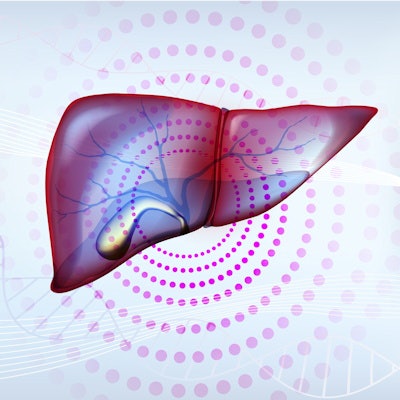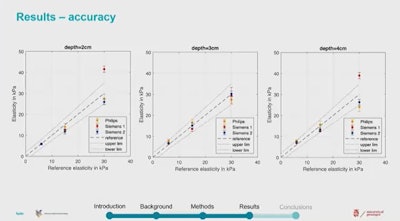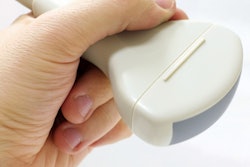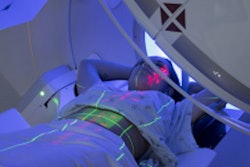
Investigators from the University of Groningen in the Netherlands reported at RSNA 2021 that point shear-wave elastography is accurate and reliable for measuring liver elasticity in chronic liver disease patients who present with fibrosis.
In her presentation, Margo van Gent from the University of Groningen in the Netherlands showed results from a study comparing point shear-wave ultrasound elastography techniques on different ultrasound systems to measure phantom elasticity. The researchers found that the systems produced similar accuracy and reliability.
"This study shows similar elasticity measurements of three ultrasound systems that are highly reproducible and in accordance with the reference values, which suggests that ultrasound-guided elastography systems is an accurate and reliable technique for liver elasticity measurements," van Gent said.
Patients with chronic liver disease develop fibrosis, which is measured in stages: F0-F1 suggests absent or mild fibrosis and the highest, F4, suggests cirrhosis. Finding out what stage of fibrosis patients have better informs clinicians on treatment options. Liver biopsy is one conventional staging technique, but it is invasive. MR elastography is a noninvasive technique, but it can be expensive and time-consuming. Van Gent wanted to focus on ultrasound elastography, which research has suggested is a cheaper, quicker option.
A few techniques exist within ultrasound elastography. Transient elastography, which uses mechanical vibration, is one the most common forms in use today. However, it does not allow for simultaneous imaging, meaning patients may need to be imaged multiple times.
Although point shear-wave elastography isn't that commonly used yet, that form of elastography does offer simultaneous imaging.
"Several studies have shown that point shear-wave elastography shows similar or better clinical results compared to transient elastography, but we're seeing in the Netherlands that transient elastography has been adopted in clinical use," van Gent said.
Van Gent et al measured phantom elasticity to evaluate the performance of ElastPQ software on an Epiq 7 (Philips Healthcare) and Virtual Touch IQ software on two Acuson Sequoia (Siemens Healthineers) systems. Both applications use point shear-wave elastography. A 5C1 transducer was also used.
The team measured three depths at two, three, and four centimeters. They also used three reference elasticities, as well as 10 repetitions per depth and per reference elasticity.
 Three elastography systems were compared in measuring elasticity in chronic liver disease patients who presented with fibrosis. All three systems were shown to be reliable. Image courtesy of Margo van Gent.
Three elastography systems were compared in measuring elasticity in chronic liver disease patients who presented with fibrosis. All three systems were shown to be reliable. Image courtesy of Margo van Gent.The researchers found that the Siemens systems showed high accuracy, with all median elasticities being within the uncertainty boundaries of the reference elasticity. The measured elasticities of either Siemens system were not significantly different from the Philips system, however.
For intrasystem reproducibility, they also found that all three systems were below the required interquartile range divided by median measurement of less than 0.3. Van Gent said this indicated that the systems are "very stable."
| Comparison of elastography systems in measuring phantom liver elasticity | |
| System | Range IQR/median |
| Philips Epic 7 (ElastPQ software) | 0.04 - 0.13 |
| Siemens Acuson Sequoia (Virtual Touch IQ software) | 0.02 - 0.13 |
| Siemens Acuson Sequoia (Virtual Touch IQ software) | 0.01 - 0.07 |
Van Gent said these results show that image-guided ultrasound elastography can be implemented in clinics to make the patient journey more efficient, and that point shear-wave elastography can be a reliable alternative to existing methods for liver fibrosis evaluations.
She also touted the method's ability to provide simultaneous imaging, which can save time for radiologists and patients.
"You can merge appointments for imaging and elastography into one," van Gent said.


















